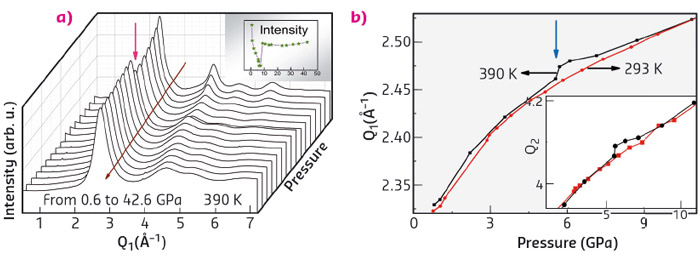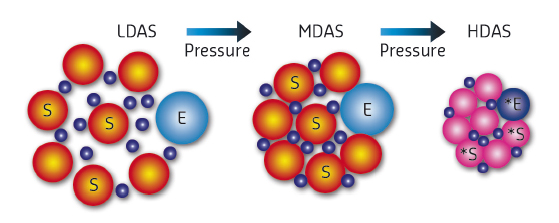- Home
- Users & Science
- Scientific Documentation
- ESRF Highlights
- ESRF Highlights 2015
- Matter at extremes
- Polyamorphism of a Ce-based metallic glass under high pressure
Polyamorphism of a Ce-based metallic glass under high pressure
Hierarchical densification processes under pressure were observed at 293 K and 390 K in a Ce-based metallic glass, arising from the hierarchy of interatomic interactions. A relatively abrupt and discontinuous transformation around 5.5 GPa was observed at 390 K, suggesting a possible weak first-order nature. Furthermore, both positive and abnormal-negative thermal expansion behaviours on medium-range order were observed in different pressure windows, due to the low-energy vibrational motions and relaxation of the weakly linked solute-centred clusters.
The microstructure transformations in glasses and/or liquids induced by high pressure or temperature, such as the liquid-liquid, liquid-glass and glass-glass transformations are the central issues in amorphous material research. The lack of long range ordered structure like in crystalline solids makes these issues still very elusive today. Polyamorphism has been observed for a long time in some glasses involving directional and open coordination environments (such as ice, silica, silicon and chalcogenide glasses). However, it was unknown whether the polyamorphous states could exist in metallic glasses, which have a very densely packed structure without directional coordination, until the work of Sheng et al., in 2007 [1]. Nevertheless, the nature of the polyamorphism in metallic glasses, such as the 4f electron delocalisation mechanism and the change of short-to-medium range ordered structures under pressure is poorly understood. Furthermore, the polyamorphic transformation process in all the previously reported metallic glass systems is gradual and occurs in a broad pressure range. Therefore, it was unclear whether the polyamorphic transition nature was of first order in the amorphous metallic system.
 |
|
Fig. 102: (a) In situ XRD patterns of the metallic glass under high pressure from 0.6 to 42.6 GPa at 390 K. The inset shows the pressure dependence of the diffraction intensity. (b) Pressure dependence of Q1 and Q2 (the inset) below 10 GPa measured at 293 and 390 K. |
We studied the densification processes of metallic glass Ce65Co25Al10 (fabricated by melt-spinning technique) under high pressure both at room temperature (293 K) and 390 K, which is near the glass transition temperature (Tg ~ 396 K), using in situ high-pressure X-ray diffraction at beamline ID27. We observed a hierarchical densification processes (from low density amorphous state, through medium density amorphous state, to high density amorphous state) at both temperatures (Figure 102 and Figure 103), arising from the inherent structural inhomogeneity and hierarchy of interatomic interactions. That is, different degree of contribution from changes of free volume zone, medium range order and short range order. The low density amorphous state-to-low density amorphous state transformation, which primarily is related to the shortening of the weak Ce-Ce bonds among the solute-centred clusters and does not undergo significant change in short-range order, is similar to the first-order isostructural a-g transition of pure Ce. In contrast, the medium density amorphous state-to-high density amorphous state transformation, associated with the change of short-range order, is somehow similar to the normal polymorphic transition in crystals involving a distinct change of the unit cell. During the densification process, the special 4f electron delocalisation of the Ce atoms assists largely in the bond shortening. Moreover, a relatively discontinuous change of volume is observed around 5.5 GPa when the experiment was performed at 390 K, while only a smooth and continuous change is observed at room temperature (293 K). The discontinuous change in volume implies a possible first-order-like nature of the polyamorphic transformation, which was hidden thus far in previous experiments due to kinetic sluggishness at lower temperatures. In addition, the Ce65Co25Al10 metallic glass shows abnormal-negative thermal expansion under a pressure range of 0.6–9.0 GPa, which could arise from a combination of the relaxation (minor role) and tilting or rocking motions of the tightly bonded polyhedral clusters linking to the weakest atom zones. The pressure-induced variation of the hierarchical bonding, will exert significant impact on the mechanical, dynamics and glass transition of various metallic glass systems due to their strong dependence on both the short range order, medium range order and linkage-atom (free volume) zones.
 |
|
Fig. 103: Illustration of hierarchical densification of Ce-based metallic glass. The smallest cyan balls represent the Ce atoms, the medium sized colour (orange and blue) balls represent the solute-centred cluster (S) and the largest colour (orange and blue) balls represent the supercluster (E). |
Principal publication and authors
Hierarchical densification and negative thermal expansion in Ce-based metallic glass under high pressure, Q. Luo (a), G. Garbarino (b), B. Sun (c), D. Fan (d,e), Y. Zhang (f), Z. Wang (c), Y. Sun (a), J. Jiao (a), X. Li (g), P. Li (g), N. Mattern (c), J. Eckert (c,h) and J. Shen (a), Nature Communications 6, 5703-5711 (2015): doi: 10.1038/ncomms6703.
(a) School of Materials Science and Engineering, Tongji University, Shanghai (China)
(b) ESRF
(c) IFW Dresden, Institute for Complex Materials, Dresden (Germany)
(d) Key Laboratory of High-temperature and High-pressure Study of the Earth’s Interior, Institute of Geochemistry, Chinese Academy of Sciences, Guiyang, (China)
(e) Center for High Pressure Science and Technology Advanced Research (HPSTAR), Changchun (China)
(f) Ames Laboratory-USDOE, Iowa State University, Ames (USA)
(g) Institute of High Energy Physics, Chinese Academy of Sciences, Beijing (China)
(h) TU Dresden, Institute of Materials Science, Dresden (Germany)
References
[1] H.W. Sheng, et al., Nature 6, 192–197 (2007).



